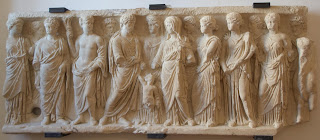Of special interest in Orvieto is its connection to the
Etruscan past of the region. The Etruscan empire encompassed most of what is
today Tuscany and parts of neighboring regions including Umbria. We were able
to see several different examples of the Etruscan past, but Orvieto has three
of the most interesting.
First, they have an excellent museum. As often happens, this
museum came from the collections of a local merchant who had an interest in the
past. Beginning in the mid-1800s, his first collections were unorganized items
he gathered because he liked them, including what became a large and
significant coin collection. Later as archaeologists became more insistent on
provenance, he began to focus on items from Orvieto, particularly from the two
necropolises beneath the town’s cliffs.
The museum houses the coin collections and an incredible set of artifacts. Of particular interest are the vases imported from Greece. The Mediterranean has long been a trading area so the fact that there was trade between Greeks and Etruscans should be no surprise. Still, it is exciting to see so many of these vases in almost pristine condition. The commentary in English was a pleasant surprise and it helped us learn about the changes in the styles of the vases over time and what that meant about the world of the time.
Closely connected to the museum are the two necropolises
that have been excavated below the cliffs of the city. By the time archaeologists
took control of the area, some of the area had been looted. However, many of
the tombs were still uncovered so there was much to learn from what was left.
Interestingly, we still are not able to read most of the Etruscan language.
What little we have figured out comes from places like these necropolises so
most of the understood words are related to death and burial leaving a great
deal undeciphered.
We were able to walk through the entire area of one of the
necropolises and peer into the graves themselves. It was a bit eerie to know
that once this had really been a city of the dead. The map showed over 250
different tombs. On another day, I walked part of the path around the town the
city has built beneath the cliffs giving me a bird’s eye view of the necropolis
and the door to what was a religious site hewn out of the cliff side. Today it
is another Catholic church. It is seldom used and not open for viewing.
 |
| Today it is a Catholic Church, But there was an Etruscan temple here first. |
 |
| The red dots are the caves The black lines are buildings above No caves under the Duomo. They were probably destroyed when building the foundations for the heavy cathedral. |
 |
| Olive presses |
Another cave had something even more interesting: pigeon
holes. During the Middle Ages, residents carved nesting holes for pigeons in
caves on the edge of the cliffs. Not being stupid, the pigeons would flock to
these holes for nesting which made them easy picking for the residents who
looked at pigeon meat as an essential part of the diet. While the pigeons no
longer use these particular holes for nesting, pigeons can still be found on
restaurant menus around town.





















No comments:
Post a Comment